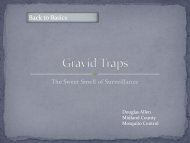Skeeter Scanner January 2012.pdf - Michigan Mosquito Control ...
Skeeter Scanner January 2012.pdf - Michigan Mosquito Control ...
Skeeter Scanner January 2012.pdf - Michigan Mosquito Control ...
Create successful ePaper yourself
Turn your PDF publications into a flip-book with our unique Google optimized e-Paper software.
The use of pyrethrins and the pyrethroids has<br />
increased during the past decade with the declining<br />
use of organophosphate pesticides, which are more<br />
acutely toxic to people and wildlife than the<br />
pyrethroids. In 2009, EPA identified the pyrethroid<br />
chemicals as having a common mechanism of<br />
toxicity and has now completed a human health<br />
cumulative risk assessment for all uses of the<br />
pyrethrins and pyrethroids.<br />
EPA's screening level cumulative assessment<br />
considers all registered uses of pyrethrins and<br />
pyrethroids and includes exposure from food,<br />
drinking water and residential settings through oral,<br />
dermal and inhalation routes of exposure. The<br />
agency considers this cumulative risk assessment to<br />
be highly conservative because it assumes that<br />
people are going to be exposed to the highest levels<br />
of residues in food, water, and in their homes all on<br />
the same day. For example, in estimating residential<br />
exposure the assessment assumed no dissipation of<br />
the chemicals, all individuals were exposed on the<br />
day of application, and exposure for each scenario<br />
occurred as a result of the pyrethroid with the<br />
highest risk estimate registered for that scenario.<br />
The assessment also assumed co-occurrence of<br />
certain residential scenarios as worst-case<br />
situations. Even using these very conservative<br />
assumptions that likely overestimate exposure to<br />
pyrethrins and pyrethroids, estimated risks to both<br />
adults and children are well below the agency’s<br />
level of concern.<br />
Suspicious Device outside County Jail<br />
A suspicious device found outside the Burlington<br />
County Jail one morning turned out to be a<br />
mosquito trap, officials said.<br />
A county corrections officer spotted the device<br />
about 8:40 a.m. between two trash bins about 50<br />
feet from the jail. The report prompted the<br />
Burlington County Sheriff's Department to restrict<br />
access to the Grant Street jail and adjacent county<br />
parking lot.<br />
Neighbors were notified of the police activity but<br />
were not ordered to evacuate, Sheriff Jean Stanfield<br />
said.<br />
The New Jersey State Police Bomb Squad was also<br />
called and responded before the trap was identified.<br />
The adjacent county administrative building was not<br />
evacuated, but some employees did choose to leave<br />
the building. All returned after a brief time.<br />
"There was no danger at any time to any of these<br />
buildings because it was on the outskirts of the<br />
parking lot," county spokeswoman Charlene<br />
Webster said of the complex, which includes the<br />
jail, courthouse and administration building.<br />
The trap was placed in the lot near the jail about 2<br />
p.m. Wednesday by the Burlington County Division<br />
of <strong>Mosquito</strong> <strong>Control</strong> to collect live mosquitoes and<br />
was due to be picked up Thursday morning.<br />
As part of their investigation, first responders<br />
reached out to various county departments,<br />
including Buildings and Grounds and <strong>Mosquito</strong><br />
<strong>Control</strong>, to try to determine if the device was a<br />
piece of their equipment, Stanfield said.<br />
<strong>Mosquito</strong> <strong>Control</strong> identified it as one of their traps.<br />
An inspector arrived for the pickup and identified<br />
and removed it, officials said.<br />
The trap caused alarm because it has an attached<br />
battery and wires. Also, there are no labels or other<br />
markings identifying it as a trap.<br />
Stanfield said the incident was a "great learning<br />
experience" for law enforcement. She said photos of<br />
the trap and another that <strong>Mosquito</strong> <strong>Control</strong> uses will<br />
be sent to authorities statewide.<br />
"We're going to share the information with other<br />
law enforcement<br />
groups so they're<br />
aware and don't<br />
waste resources<br />
if another trap is<br />
reported,"<br />
Stanfield said.<br />
She said the<br />
county traps will<br />
also be labeled to<br />
avoid confusion.<br />
4






